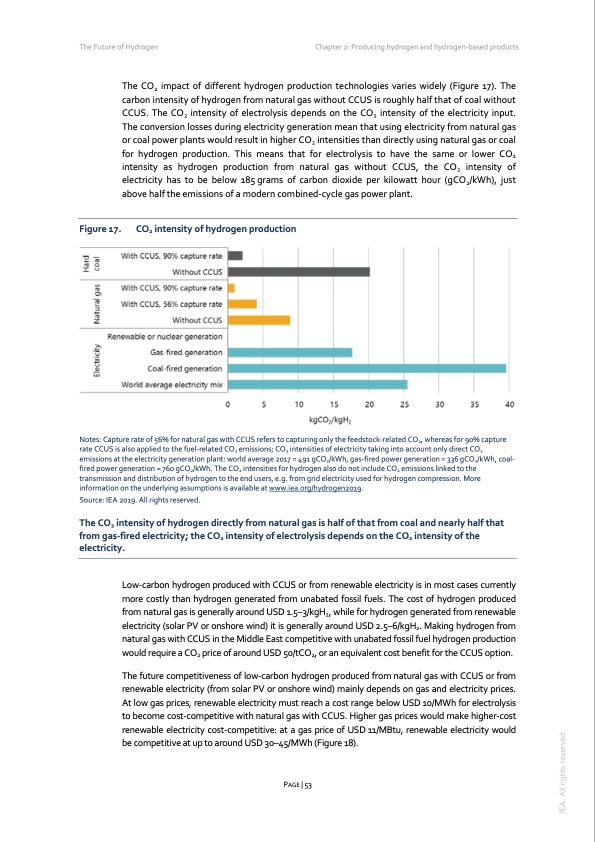
PDF Publication Title:
Text from PDF Page: 053
The Future of Hydrogen Chapter 2: Producing hydrogen and hydrogen-based products Figure 17. The CO2 impact of different hydrogen production technologies varies widely (Figure 17). The carbon intensity of hydrogen from natural gas without CCUS is roughly half that of coal without CCUS. The CO2 intensity of electrolysis depends on the CO2 intensity of the electricity input. The conversion losses during electricity generation mean that using electricity from natural gas or coal power plants would result in higher CO2 intensities than directly using natural gas or coal for hydrogen production. This means that for electrolysis to have the same or lower CO2 intensity as hydrogen production from natural gas without CCUS, the CO2 intensity of electricity has to be below 185 grams of carbon dioxide per kilowatt hour (gCO2/kWh), just above half the emissions of a modern combined-cycle gas power plant. CO2 intensity of hydrogen production Notes: Capture rate of 56% for natural gas with CCUS refers to capturing only the feedstock-related CO2, whereas for 90% capture rate CCUS is also applied to the fuel-related CO2 emissions; CO2 intensities of electricity taking into account only direct CO2 emissions at the electricity generation plant: world average 2017 = 491 gCO2/kWh, gas-fired power generation = 336 gCO2/kWh, coal- fired power generation = 760 gCO2/kWh. The CO2 intensities for hydrogen also do not include CO2 emissions linked to the transmission and distribution of hydrogen to the end users, e.g. from grid electricity used for hydrogen compression. More information on the underlying assumptions is available at www.iea.org/hydrogen2019. Source: IEA 2019. All rights reserved. The CO2 intensity of hydrogen directly from natural gas is half of that from coal and nearly half that from gas-fired electricity; the CO2 intensity of electrolysis depends on the CO2 intensity of the electricity. Low-carbon hydrogen produced with CCUS or from renewable electricity is in most cases currently more costly than hydrogen generated from unabated fossil fuels. The cost of hydrogen produced from natural gas is generally around USD 1.5–3/kgH2, while for hydrogen generated from renewable electricity (solar PV or onshore wind) it is generally around USD 2.5–6/kgH2. Making hydrogen from natural gas with CCUS in the Middle East competitive with unabated fossil fuel hydrogen production would require a CO2 price of around USD 50/tCO2, or an equivalent cost benefit for the CCUS option. The future competitiveness of low-carbon hydrogen produced from natural gas with CCUS or from renewable electricity (from solar PV or onshore wind) mainly depends on gas and electricity prices. At low gas prices, renewable electricity must reach a cost range below USD 10/MWh for electrolysis to become cost-competitive with natural gas with CCUS. Higher gas prices would make higher-cost renewable electricity cost-competitive: at a gas price of USD 11/MBtu, renewable electricity would be competitive at up to around USD 30–45/MWh (Figure 18). PAGE | 53 IEA. All rights reserved.PDF Image | The Future of Hydrogen 2019

PDF Search Title:
The Future of Hydrogen 2019Original File Name Searched:
the_future_of_hydrogen.pdfDIY PDF Search: Google It | Yahoo | Bing
NFT (Non Fungible Token): Buy our tech, design, development or system NFT and become part of our tech NFT network... More Info
IT XR Project Redstone NFT Available for Sale: NFT for high tech turbine design with one part 3D printed counter-rotating energy turbine. Be part of the future with this NFT. Can be bought and sold but only one design NFT exists. Royalties go to the developer (Infinity) to keep enhancing design and applications... More Info
Infinity Turbine IT XR Project Redstone Design: NFT for sale... NFT for high tech turbine design with one part 3D printed counter-rotating energy turbine. Includes all rights to this turbine design, including license for Fluid Handling Block I and II for the turbine assembly and housing. The NFT includes the blueprints (cad/cam), revenue streams, and all future development of the IT XR Project Redstone... More Info
Infinity Turbine ROT Radial Outflow Turbine 24 Design and Worldwide Rights: NFT for sale... NFT for the ROT 24 energy turbine. Be part of the future with this NFT. This design can be bought and sold but only one design NFT exists. You may manufacture the unit, or get the revenues from its sale from Infinity Turbine. Royalties go to the developer (Infinity) to keep enhancing design and applications... More Info
Infinity Supercritical CO2 10 Liter Extractor Design and Worldwide Rights: The Infinity Supercritical 10L CO2 extractor is for botanical oil extraction, which is rich in terpenes and can produce shelf ready full spectrum oil. With over 5 years of development, this industry leader mature extractor machine has been sold since 2015 and is part of many profitable businesses. The process can also be used for electrowinning, e-waste recycling, and lithium battery recycling, gold mining electronic wastes, precious metals. CO2 can also be used in a reverse fuel cell with nafion to make a gas-to-liquids fuel, such as methanol, ethanol and butanol or ethylene. Supercritical CO2 has also been used for treating nafion to make it more effective catalyst. This NFT is for the purchase of worldwide rights which includes the design. More Info
NFT (Non Fungible Token): Buy our tech, design, development or system NFT and become part of our tech NFT network... More Info
Infinity Turbine Products: Special for this month, any plans are $10,000 for complete Cad/Cam blueprints. License is for one build. Try before you buy a production license. May pay by Bitcoin or other Crypto. Products Page... More Info
| CONTACT TEL: 608-238-6001 Email: greg@infinityturbine.com | RSS | AMP |